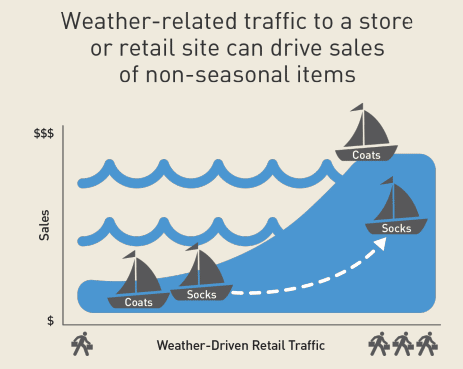Weather & Retail Myth #4: My Products Aren’t Seasonal, So the Weather Doesn’t Affect Me
Many categories — from lawn fertilizer to knitwear to sun care — are obviously impacted by the weather, but it can be surprising to learn how much non-seasonal products are also affected. Over 90 percent of a business’s annual weather-driven sales come from day-to-day changes in temperature and precipitation that influence consumer shopping patterns and behaviors.
When analytics are used to isolate how much of a product’s sales volatility is weather-related, some revealing insights emerge. Jewelry is three times more weather-sensitive in January than during the rest of the year. Why might this be? In January, consumers are often looking to redeem gift cards and take advantage of post-holiday sales. Favorable weather in January (typically warmer and drier than normal) can drive store traffic and lift jewelry sales in advance of Valentine’s Day. Of course, when the inverse occurs and the weather is cold and snowy, jewelry sales can be limited.
Similarly, coffee — a daily habit for many — sees sales swings of 5 percent on average due to the weather. These swings vary based on the time of year and market; major markets in the Northeast can experience strong coffee demand of 10 percent above normal levels when cool weather extends into spring months.

When it comes to store or site traffic, “a rising tide lifts all boats.” If favorable weather conditions bring customers into stores for a seasonal item such as charcoal, there is a good chance they may pick up additional items on their shopping trip (ketchup, shampoo, etc.). On the other hand, if poor weather keeps customers away, a mass merchant is going to see sales fall across the board, including in non-seasonal departments like home goods, toys, and electronics.
Finally, deweatherizing sales histories to correct weather-based sales distortions drives forecast accuracy improvements. It is common for businesses to realize a 50-200 basis point accuracy improvement on nonseasonal, high volume, year-round categories. This results in measurable financial benefits by increasing in-stock levels and reducing inventory carrying costs.
Check out the 5 Myths About the Weather & Its Impact on Retail from the NRF to learn more.
